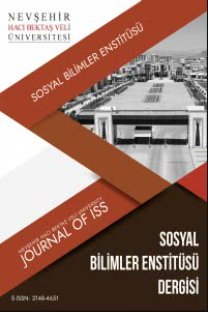FROM NATIVE TO CONTINENTAL: RELIGIOUS LANDSCAPE IN EARLY MEDIEVAL JAPAN
From Native To Continental: Religious Landscape In Early Medieval Japan
___
- Atik, K. (2012a). Japonya, Kapalı Ülke, İdeoloji ve Din. Doğu-Batı, 60, 101–118.
- Atik, K. (2012b). Kore Aydınlanması: Joseon Dönemi. Doğu Batı, 61, 217–232.
- Beckwith, C. I. (2004). Koguryo, the Language of Japan’s Continental Relatives: An Introduction to the Historicalcomparative Study of the Japanese Koguryoic Languages with a Preliminary Description of Archaic Northeastern Middle Chinese. Brill.
- Como, M. (2007). Shotoku: Ethnicity, Ritual, and Violence in the Japanese Buddhist Tradition. Oxford University Press.
- Grapard, A. G. (1999). Religious Practices. In The Cambridge History of Japan (Vol. 2). Cambridge University Press.
- Hane, M. (1990). Premodern Japan: A Historical Survey. Westview Press.
- Hong, W. (1988). Relationship Between Korea and Japan in Early Period: Paekche and Yamato Wa. Ilsimsa.
- Ilyon. (2008). Samguk Yusa: Legends And History Of The Three Kingdoms Of Ancient Korea (G. Mintz, Ed.; T.-H. Ha, Trans.). Silk Pagoda.
- Ilyon. (2011). 삼국유사 [Samguk Yusa: Legends of the Three Kingdoms]. Maewoldang.
- Kadıoğlu, M. (2018). Roots of Warrior Ideal and Ideology in Meiji Army. In E. Saritas (Ed.), Social Sciences Studies in Turkey. Trafford Publishing.
- Kasamatsu, H., Sato, S., & Momose, K. (1981). 中世政治社会思想 [Chûse Seiji Shakai Shisô] (Vol. 2). Iwanami Shoten.
- Kim, P. (1914). 三國史記 [Samguk Sagi: Historical Records of the Three Kingdoms]. 朝鮮研究會 [Chaoxian Yanjiuhui: Korea Research Association].
- Kim, P. (2006). A History of the Early Korean Kingdom of Paekche: Together with an Annotated Translation of the Paekche Annals of the Samguk Sagi (J. W. Best, Trans.). Harvard University Asia Center.
- Kim, P. (2012). The Koguryo Annals of the Samguk Sagi (E. J. Shultz & H. H. W. Kang, Eds.; G. Kenneth H.G., H. H. W. Kang, & S. Edward, Trans.; 2nd ed.). Academy of Korean Studies Press.
- Kimura, S. (2009). 中世社会の成り立ち [Chûsei Shakai no Naritachi] (4th ed.). Yoshikawa Kobunkan.
- Miyazaki, C. (1999). 中国文明論集 [Chūgoku Bunmei Ronshū ] (4th ed.). Iwanami Shoten.
- Morris, I. (1994). The World of the Shining Prince: Court Life in Ancient Japan (4th ed.). Kodansha International.
- Nonno, T. (2015). On Ainu Etymology of Key Concepts of Shintō: Tamashii and Kami. CAES/Chiba, 1(1), 24–35.
- Sato, S. (1983). 日本の中世国家 [Nihon no Chûse Kokka]. Iwanami Shoten.
- Sato, S. (1990). 日本中世史論集 [Nihon Chûseshi Ronshû]. Iwanami Shoten.
- Sonada, K. (2008). Early Buddha Worship. In J. W. Hall (Ed.), & M. B. Delmer (Trans.), Cambridge History of Japan: Heian (3rd ed., Vol. 1). Cambridge University Press.
- Tamura, K. (2008). 동아시아의 도성과 발해 [Dong Asiaeui Doseonggwa Balhae]. Tongbuga Yeoksa Jaedan.
- Totman, C. (1981). Japan before Perry: A Short History. University of California Press.
- Ury, M. (2008). Chinese Learning and Intellectual Life. In Cambridge History of Japan (Vol. 2). Cambridge University Press.
- Wang, Z. (2016). 魏晋南北朝史 [Wei Jin Nanbei Chaoshi] (2nd ed.). Shanghai Renmin Chubanshe.
- Watanabe, S. (2014). 名著で読む日本史 [Meichode Yomu Nihonshi] (2nd ed.). Ikuhosha.
- Yayın Aralığı: 4
- Başlangıç: 2011
- Yayıncı: Nevşehir Hacı Bektaş Veli Üniversitesi
NORTHROP FRYE’IN MİT SİSTEMATİĞİNE GÖRE EYLÜL ROMANININ İNCELENMESİ
ANTİK ÇAĞDA KADIN VE HURMA İLİŞKİSİNE DAİR BAZI DÜŞÜNCELER
TÜRKİYE’DE EĞİTİM HARCAMALARI GELİR DAĞILIMI VE ENFLASYON İLİŞKİSİ: EŞBÜTÜNLEŞME ANALİZİ
DIŞSALLIKLA MÜCADELEDE DÜZENLEYİCİ VE DENETLEYİCİ KURUMLARIN ROLÜ: RTÜK ÖRNEĞİ
ZİYARET FENOMENİ VE BİR TEDAVİ MERKEZİ OLARAK KAYSERİ ZİYARET YERLERİ
TÜRKİYE’DE HAYAT BOYU ÖĞRENME KONUSUNDA YAPILAN TEZLERİN BİBLİYOGRAFİK DEĞERLENDİRİLMESİ
Gül ÖZÜDOĞRU, Önder BALTACI, Bilal ÖZÇAKIR
THE RELATIONSHIP BETWEEN CLASSROOM MANAGEMENT AND LEARNING: A SYSTEMATIC REVIEW
Pinar KUCUKAKİN, Cennet GÖLOĞLU DEMİR
19. YY OSMANLI EKONOMİSİNDE GALATA BANKERLERİNİN ROLÜ: BALTAZZİ AİLESİ ÖRNEĞİ
